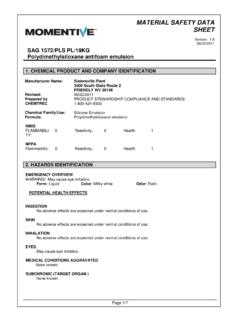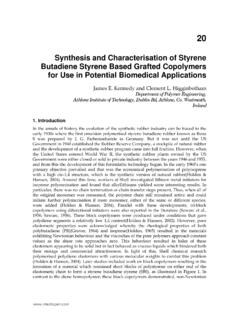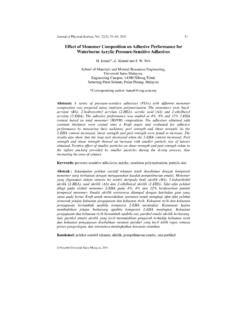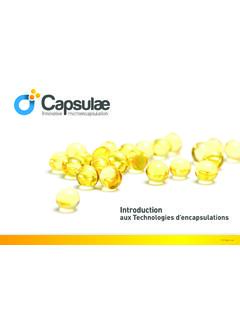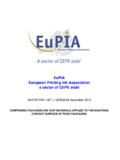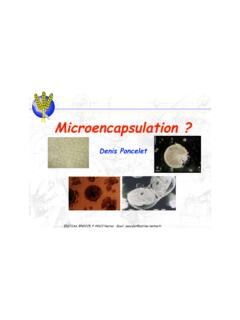Transcription of Surfactant Science: Principles and Practice - Steven Abbott
1 Surfactant Science: Principles and PracticeProf Steven AbbottSteven Abbott TCNF Ltd, Ipswich, UK and Visiting Professor, University of Leeds, 20 September 2015 Initial 23 September 2015 Addition of Surfactant 26 January 2016 Minor 07 March 2016 Update to new website and Fast 03 October 2018 Update on NAC calculations plus minor 28 November 2019 Update with the new Acosta Polar Oil 20 January 2019 Update on foam makingCopyright 2015/20 Steven AbbottThis book is distributed under the Creative Commons BY-ND.
2 Attribution and No-Derivatives 6 Abbreviations and Symbols 121 Some Basics A summary in 9 images What s not included CMC, m, A, K, E. Who cares? Why CPP is mostly useless Bancroft s Rule Why HLB should be banned Surfactant blends Elasticity and bending Cloud Point and Krafft Point Dynamic Surface Tension Classic DST DST around equilibrium Partition coefficient Measuring partition coefficients The basics summarised 472 HLD towards rational emulsions Specific HLD examples A waste of good Surfactant Extended Oil Recovery.
3 EOR Measuring Cc and EACN Scan tricks Phase volumes Fast scans Silicone oils Winsor R ratio and Packing Parameter Who cares about microemulsions? HLD is not enough 683 NAC Net Average Curvature What can NAC do? More fish power from NAC More power from NAC the fishtail plot PIF Phase Inversion Formulation Going on for ever The problem of Phase volumes Other ways to look at Creating a large for efficiency C C Silicone oils The point of this chapter 934 Emulsions The numbers behind an emulsion Size distributions Viscosity Avoiding destruction Creaming Ostwald Ripening Flocculation Coalescence DLVO Dynamic barriers.
4 Elasticity, Gibbs-Marangoni and Wedges How to make an emulsion How not to make an emulsion Predicting drop size Using HLD-NAC Emulsions by Catastrophic Inversion Pickering emulsions 1335 Foams Foam basics Elasticity Foam DLVO Ostwald ripening Foam Drainage Foam Rheology Antifoams Practical issues 3 Coefficients The Entry Barrier problem Fast and slow Disappearing antifoam Now for the science bit Making foams Foam making essentials But what about my Surfactant
5 System? The view from 2020 Foaming techniques Measurements of key parameters. Foam fractionation 1756 Problems The polar oil problem Building on the CIT model Polar oils as surfactants and oils Linkers, hydrotropes etc. From problem to opportunity m, A, K and elasticity Curvature and IFT Together 1957 Phase diagrams Phases Binary diagrams Ternary diagrams Reading values from a ternary diagram Paths through phase diagrams Diagrams with 2-phase regions Diagrams with 3-phase regions HLD-NAC and microemulsion diagrams General ternary diagrams 2128 Putting the Principles into Practice Detergency EOR Soil remediation Dealing with oil spills Cosmetics emulsions emulsion Polymerisation Making inorganic nanoparticles
6 emulsion Separation Bicontinuous Microemulsions Microemulsion solvent cleaners Cosmetic microemulsions Levelling of paints and coatings Surfactants to fix pinholes Surfactants to fix other levelling issues High throughput Phase scans for Cc, EACN etc. Phase diagrams Small volume tricks Surfactants as Solubilizers The future of Surfactant formulation Practice 260 PrefaceThe target audience for this book is a younger version of myself. I have included all those things I wish I had known years ago.
7 Had I had this book, my life of formulating with surfactants would have been so much more productive!This book, therefore, contains everything that I know about Surfactant science that can be useful to someone (such as myself) who formulates with surfactants. So it is a good idea to make it clear right from the start that although there are many good answers to many of our formulation questions (and these answers generally are not the ones you read about) there are lots of Surfactant questions for which Surfactant science currently has no satisfactory we will see, I am happy to blame the Surfactant community for having wasted decades by not working with the best available Surfactant theory, and therefore not having the time or the clarity to investigate the extra questions for which formulators really wanted answers.
8 More specifically I lay the blame on those in academia and industry who perpetuated the myth that armed with critical micelle concentration, CMC, and with hydrophilic lipophilic balance, HLB, one could formulate wisely. As countless formulators have found, these, the only numbers that are generally mentioned in the Surfactant literature, are largely useless for most purposes. Those who formulate exclusively with ethoxylates will take some exception to this. Because ethoxylates can be formulated with any combination of alkane and ethoxylate chain lengths there have been endless studies and correlations from which a formulator can derive some useful answers armed only with the CMC and HLB values.
9 Ethoxylates, however, are a good part of the larger problem because their somewhat rational behaviour has been used as a cover to pretend that the rest of Surfactant science can use ethoxylate-based techniques. This is simply untrue. Outside the world of ethoxylates, HLB is largely meaningless and valueless. And few of us can take long lists of CMC values and reach deep insights into our formulation good news is that once you exit the world of HLB there are a set of scientific Principles (especially HLD) on which to build a much more solid base for formulations.
10 In some areas the formulations can be entirely rational. In other areas we at least know which bits of science are lacking so the formulator can tell how far to push the science before relying on whatever other resources lie to always found Surfactant science hard, and regularly skipped over stuff I thought was useless or irrelevant. My aim in this book is to give you the science you really must know, and give it in the easiest-possible manner. That means a book/app hybrid. Every key equation in the book is linked to an app that brings the equation to life.

